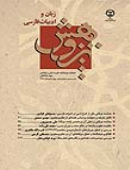تفاوت و تقابل نسلها در آثار سعدي
محورهای موضوعی : پژوهشهای ادبیات کلاسیک ایرانناصر نیکوبخت 1 , حسن شاهیپور 2
1 -
2 -
کلید واژه: تقابل نسلها جوان جواني سعدي و جواني مناسبات نسلي,
چکیده مقاله :
مناسبات نسلي و تفاوت و تقابل نسلها، از دغدغههاي اصلي همه ملل در طول تاريخ بشر بوده و همواره توجه مصلحان اجتماعي را به خود معطوف كرده است. تحولات اجتماعي، سياسي، اقتصادي و به طور كلي تكامل جوامع و مخصوصاً پديده صنعتي شدن، تأثيرات محسوسي بر هنجارهاي رفتاري نسلها داشته است كه از اين ميان، با توجه به اقتضائات خاص دوره جواني، اين تفاوت رفتاري در اين نسل محسوستر و ملموستر جلوه كرده است. سعدي، در ضمن داستانها و حكايات كوتاه با اشاره به پارهاي از اين تفاوتها و تقابلها، آن را امري طبيعي و عادي برشمرده، هرچند درصدد بيان علل و عوامل اين گسست برنيامده است. او ميكوشد با تكيه بر آموزههاي اخلاقي، جوانان را به طاعتپذيري و تجربهاندوزي از پيران دعوت كند و اغلب با دفاع از ارزشها و سنتهاي اجتماعي، پيران را در شيوههاي رفتاري محقتر ميداند. در ادامه مقاله پارهاي اندرزها و نصايح سعدي به دو نسل جوان و پير احصا شده و قضاوت نهايي را به خواننده واگذار كردهايم كه تا چه حد آموزههاي اخلاقي ادبيات تعليمي گذشته، ميتواند امروزيان را در ترميم گسست نسلي ياري نمايد.
Of human being concerns throughout the history, was generational relations, generation difference and conflict which have drawn social reformists’ attention, persistently. Social, political, economic developments and evolution of communities and particularly industrialization, have had tangible impacts on behavioural norms of generations, that, given special requirement of youth, this behavioural difference have been proved in this generation more tangible and obvious. Saadi, during short history and anecdotes, pointing to some of these conflicts and differences, considered it natural and usual, though didn’t seek to address reasons and causes of this divide. Relying on moral teachings, he attempts to invite youth to follow the elders and use of their experiences. Defending social values and traditions, he prefers behavioural patterns of the aged. Subsequently, some Saadi’ advices and his recommendations to the youth and the aged summarized in this essay, and finally the readers will judge to what extent moral teachings belong to past didactic literature might help contemporary generations to repair generational divide.


